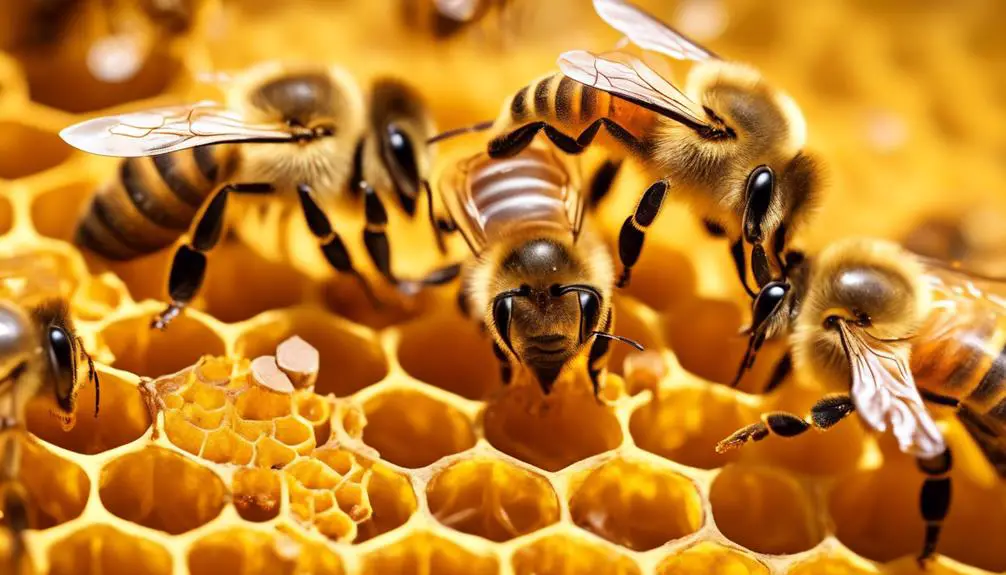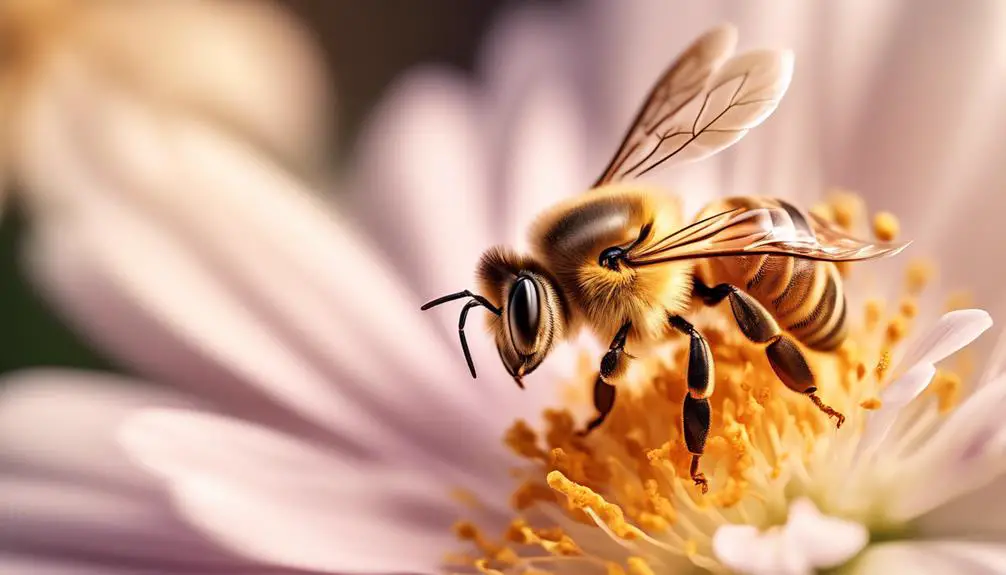Find out if honey bees, despite their lack of visible ears, are truly deaf or if their sensory world is more complex than imagined.

Are Honey Bees Deaf
You watch them buzz around your garden, collect pollen from flowers, and dance in the air; you may even be aware that honey bees possess an intricate method of communication. But have you ever wondered if these industrious creatures can hear?
Despite their lack of visible ears, bees are not deaf, at least not in the way we understand deafness. The world of a bee, especially when it comes to their sensory experiences, is far more complex than you might think.
So, let's plunge into the fascinating world of bees and their unique perception of sound.
Key Takeaways
- Bees lack conventional ears but have sensitive sensory hairs and antennae for detecting vibrations.
- Johnston's organ in bees' antennae can pick up sounds from up to 200 meters away.
- Bees rely on other sensory modalities like touch, sight, and magnetoreception for communication and navigation.
- Noise pollution can disrupt bees' ability to perceive crucial sound vibrations, impacting their behavior and ecosystem services.
Understanding Honey Bee Communication

To comprehend honey bee communication, you must delve into the unique world of bee dances, odorous pheromones, and tactile interactions. Bees aren't deaf, but they've evolved a sophisticated suite of communication methods that bypass auditory signals. The first and most famous of these is the 'waggle dance' – a performance by a forager bee that conveys the location of a food source to its hive mates. The angle of the dance indicates the direction relative to the sun, while the duration of the waggle phase communicates distance.
Pheromones play an equally crucial role in bee communication. These chemical signals influence a wide range of behaviors, including foraging, defense, reproduction, and swarm formation. Alarm pheromones, for instance, warn the colony of impending threats.
Tactile interactions are also essential, particularly during the queen's mating flight. Drones grasp the queen with claspers on their abdomen, enabling insemination.
Therefore, while they may not 'hear' in the conventional sense, bees have a complex, multifaceted communication system. It's a testament to their evolutionary ingenuity and an intriguing puzzle for scientists studying their behavior.
The Sensory World of Bees

Diving into the sensory world of bees, you'll discover an intricate system heavily reliant on sight, smell, taste, touch, and even magnetoreception. These tiny creatures have evolved to use a multitude of cues from their environment, enabling them to navigate, find food, and communicate with each other.
Bees' eyes are attuned to ultraviolet light, which allows them to see patterns on flowers that are invisible to us. Their antennae serve as an all-in-one sensory organ, picking up smells, tastes, and even the direction of the wind. Touch is also essential, especially during the waggle dance, a unique form of communication among bees. Magnetoreception, the ability to sense the Earth's magnetic field, is another fascinating aspect of bees' sensory abilities. This is thought to help them navigate long distances.
To better appreciate these amazing creatures, let's look at this table:
Sense | Function |
|---|---|
Sight | Locates food and guides navigation |
Smell | Detects pheromones and identifies food |
Taste | Assesses food quality |
Touch | Facilitates communication |
Magnetic sense | Aids in long-distance navigation |
Understanding the sensory world of bees can deepen our respect for these crucial pollinators and their sophisticated means of interacting with the world.
Do Bees Have Ears?

While we've explored the primary senses bees use to interact with their environment, you might be wondering if these insects possess the ability to hear. To answer this, we need to delve into the anatomy of bees. Unlike humans, bees don't have ears on the sides of their heads. Instead, they've a network of sensory hairs and antennae that serve a similar function.
These sensory hairs, particularly those on the antennae, are highly sensitive to air particles' vibrations. When these particles vibrate due to sound, the bees perceive these vibrations as signals. This allows them to respond to the environment effectively, despite not having conventional ears.
Moreover, bees also use Johnston's organ located in their antennae to detect airborne vibrations. Scientists have found that this organ can pick up sounds from at least 200 meters away. This ability helps bees to communicate, navigate, and locate flowers.
How Bees Perceive Sound

Understanding how bees perceive sound requires a closer look at their unique sensory apparatus and their fascinating behaviors. While bees don't have ears like humans, they're far from deaf. Instead, they utilize their antennae and body hairs in a way you mightn't expect.
Their antennae, much like our ears, pick up sound waves from the environment. These antennae are finely tuned to detect vibrations in the air, which are processed and interpreted as sensory information. For bees, these vibrations could signal a predator, the presence of food, or the need for communication with their hive mates.
Now, consider their body hairs. Bees have hairs all over their bodies, and these hairs also play a crucial role in how they perceive sound. When sound waves hit these hairs, they move in response, creating a vibratory signal. This signal is then converted into an electrical signal which is sent to the bee's brain.
Impact of Noise Pollution on Bees

Noise pollution, particularly from urban and industrial sources, can severely disrupt the bee's ability to perceive these crucial sound vibrations, posing a significant threat to their survival. This disruption interferes with their daily activities, such as communication, navigation, and nectar collection, which are essential for their survival and productivity.
Continuous noise exposure can cause chronic stress in bees, altering their behavior and physiology. Studies show that stress responses can result in decreased foraging efficiency, changes in flight patterns, and a reduction in colony growth. You'll notice that bees also become less effective in pollination, a crucial ecosystem service they provide.
Moreover, noise pollution affects the bee's communication system. It's crucial to understand that bees rely on subtle vibrations to communicate within the hive. They can't 'hear' in the conventional sense but sense these vibrations through their bodies. When noise pollution interferes with these vibrations, it's akin to drowning out their language, resulting in communication breakdowns.
In a nutshell, noise pollution doesn't just pose a threat to bees' survival; it endangers the essential services they provide to our ecosystems. It's high time you recognized this threat and took measures to mitigate it.
Conclusion
So, are honey bees deaf? Not quite. They may lack ears, but they perceive sound through vibrations received by Johnston's organs in their antennae.
Noise pollution can disrupt this, impacting their communication and navigation. Understanding the sensory world of bees is crucial to safeguarding their survival and, by extension, our ecosystems.
Remember, the hum of bees isn't only a part of our summer soundtrack, but also a vital symphony for our planet's health.


